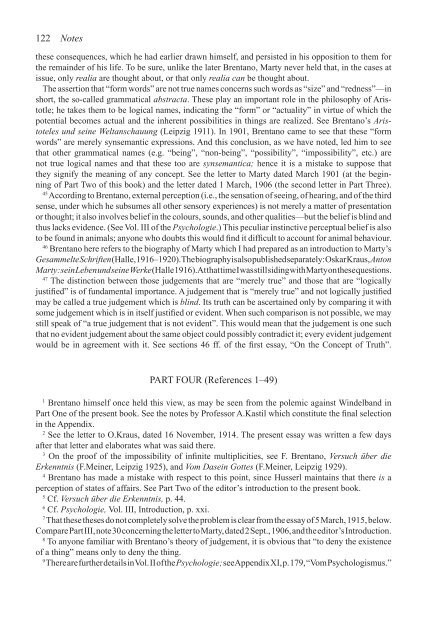Franz Brentano_The True and the Evident.pdf
Franz Brentano_The True and the Evident.pdf
Franz Brentano_The True and the Evident.pdf
Create successful ePaper yourself
Turn your PDF publications into a flip-book with our unique Google optimized e-Paper software.
122 Notes<br />
<strong>the</strong>se consequences, which he had earlier drawn himself, <strong>and</strong> persisted in his opposition to <strong>the</strong>m for<br />
<strong>the</strong> remainder of his life. To be sure, unlike <strong>the</strong> later <strong>Brentano</strong>, Marty never held that, in <strong>the</strong> cases at<br />
issue, only realia are thought about, or that only realia can be thought about.<br />
<strong>The</strong> assertion that “form words” are not true names concerns such words as “size” <strong>and</strong> “redness”—in<br />
short, <strong>the</strong> so-called grammatical abstracta. <strong>The</strong>se play an important role in <strong>the</strong> philosophy of Aristotle;<br />
he takes <strong>the</strong>m to be logical names, indicating <strong>the</strong> “form” or “actuality” in virtue of which <strong>the</strong><br />
potential becomes actual <strong>and</strong> <strong>the</strong> inherent possibilities in things are realized. See <strong>Brentano</strong>’s Aristoteles<br />
und seine Weltanschauung (Leipzig 1911). In 1901, <strong>Brentano</strong> came to see that <strong>the</strong>se “form<br />
words” are merely synsemantic expressions. And this conclusion, as we have noted, led him to see<br />
that o<strong>the</strong>r grammatical names (e.g. “being”, “non-being”, “possibility”, “impossibility”, etc.) are<br />
not true logical names <strong>and</strong> that <strong>the</strong>se too are synsemantica; hence it is a mistake to suppose that<br />
<strong>the</strong>y signify <strong>the</strong> meaning of any concept. See <strong>the</strong> letter to Marty dated March 1901 (at <strong>the</strong> beginning<br />
of Part Two of this book) <strong>and</strong> <strong>the</strong> letter dated 1 March, 1906 (<strong>the</strong> second letter in Part Three).<br />
45 According to <strong>Brentano</strong>, external perception (i.e., <strong>the</strong> sensation of seeing, of hearing, <strong>and</strong> of <strong>the</strong> third<br />
sense, under which he subsumes all o<strong>the</strong>r sensory experiences) is not merely a matter of presentation<br />
or thought; it also involves belief in <strong>the</strong> colours, sounds, <strong>and</strong> o<strong>the</strong>r qualities—but <strong>the</strong> belief is blind <strong>and</strong><br />
thus lacks evidence. (See Vol. III of <strong>the</strong> Psychologie.) This peculiar instinctive perceptual belief is also<br />
to be found in animals; anyone who doubts this would find it difficult to account for animal behaviour.<br />
46 <strong>Brentano</strong> here refers to <strong>the</strong> biography of Marty which I had prepared as an introduction to Marty’s<br />
Gesammelte Schriften (Halle, 1916–1920). <strong>The</strong> biography is also published separately: Oskar Kraus, Anton<br />
Marty: sein Leben und seine Werke (Halle 1916). At that time I was still siding with Marty on <strong>the</strong>se questions.<br />
47 <strong>The</strong> distinction between those judgements that are “merely true” <strong>and</strong> those that are “logically<br />
justified” is of fundamental importance. A judgement that is “merely true” <strong>and</strong> not logically justified<br />
may be called a true judgement which is blind. Its truth can be ascertained only by comparing it with<br />
some judgement which is in itself justified or evident. When such comparison is not possible, we may<br />
still speak of “a true judgement that is not evident”. This would mean that <strong>the</strong> judgement is one such<br />
that no evident judgement about <strong>the</strong> same object could possibly contradict it; every evident judgement<br />
would be in agreement with it. See sections 46 ff. of <strong>the</strong> first essay, “On <strong>the</strong> Concept of Truth”.<br />
PART FOUR (References 1–49)<br />
1 <strong>Brentano</strong> himself once held this view, as may be seen from <strong>the</strong> polemic against Windelb<strong>and</strong> in<br />
Part One of <strong>the</strong> present book. See <strong>the</strong> notes by Professor A.Kastil which constitute <strong>the</strong> final selection<br />
in <strong>the</strong> Appendix.<br />
2 See <strong>the</strong> letter to O.Kraus, dated 16 November, 1914. <strong>The</strong> present essay was written a few days<br />
after that letter <strong>and</strong> elaborates what was said <strong>the</strong>re.<br />
3 On <strong>the</strong> proof of <strong>the</strong> impossibility of infinite multiplicities, see F. <strong>Brentano</strong>, Versuch über die<br />
Erkenntnis (F.Meiner, Leipzig 1925), <strong>and</strong> Vom Dasein Gottes (F.Meiner, Leipzig 1929).<br />
4 <strong>Brentano</strong> has made a mistake with respect to this point, since Husserl maintains that <strong>the</strong>re is a<br />
perception of states of affairs. See Part Two of <strong>the</strong> editor’s introduction to <strong>the</strong> present book.<br />
5 Cf. Versuch über die Erkenntnis, p. 44.<br />
6 Cf. Psychologie, Vol. III, Introduction, p. xxi.<br />
7 That <strong>the</strong>se <strong>the</strong>ses do not completely solve <strong>the</strong> problem is clear from <strong>the</strong> essay of 5 March, 1915, below.<br />
Compare Part III, note 30 concerning <strong>the</strong> letter to Marty, dated 2 Sept., 1906, <strong>and</strong> <strong>the</strong> editor’s Introduction.<br />
8 To anyone familiar with <strong>Brentano</strong>’s <strong>the</strong>ory of judgement, it is obvious that “to deny <strong>the</strong> existence<br />
of a thing” means only to deny <strong>the</strong> thing.<br />
9 <strong>The</strong>re are fur<strong>the</strong>r details in Vol. II of <strong>the</strong> Psychologie; see Appendix XI, p. 179, “Vom Psychologismus.”
















